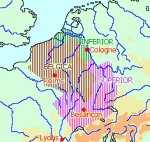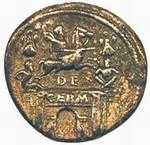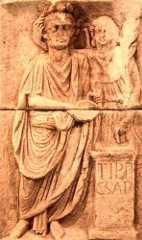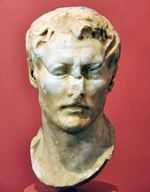

| home : index : ancient Rome : article by Jona Lendering � | ||
Germania inferior (1) |  | |
provinceCologneConquestand defeatJuliusCaesarwas the first Roman general to invade the Low Countries. In the summerof 57 BCE, he defeated the Nervians (text)and -proceeding along anancientroad- the Aduatuci in the valley of the Meuse (more),and in the spring of 55, he repelled the Usipetes and Tencteri, twotribesthat had invaded the region (text).A couple of months later, he bridged theRhineand invaded the country near the river Ruhr. One lasting result was acoalitionwith the Ubians, a tribe on the east bank of the Rhine.Everything seemed under control, but in the winter of54/53, there wasa setback, when kingAmbiorixof theEburones was able to annihilate a Romanlegion.Caesar's rapid reaction was extremely violent: within 300 days, theEburoneswere exterminated (text).Ambiorix' allies, the Menapians, were hunted down. Their 7,000 warriorswere no match for the 18,000 legionaries. After these actions, theMeuse-Rhinearea was as quiet as a graveyard. After this war, the Low Countries disappear from oursources, exceptfor a brief remark by Varro, who tells that there are no olive treesandvines along the Lower Rhine, and describes how the land is marled andhowsalt is extracted from burned wood (On agriculture1.7.8). | Tribes and languages Romanization I Romanization II The legions The western border Caligula and Corbulo The Batavian revolt The limes The towns The towns (cont'd) The countryside Crops Taxes, trade andcrafts Religion The third century The fourth century The languageboundary Christianity The Franks | |
 Bust of Agrippa from Magnesia on the Meander (Altes Museum, Berlin) | In 39 and 38, MarcusVipsanius Agrippa wasgovernorof Gaul, and fought a war on the east bank of the Rhine on behalf oftheUbians against the Suebians, a Germanic tribe that was notorious foritsaggressiveness. After the campaign, Agrippa resettled the Ubians on thewest bank. Thiswas easy, because after the wars of Caesar, the area was almost empty.The settlers remained loyal allies of the Romans and built a town thatwas calledAra Ubiorum, 'the altar of the Ubians',modernCologne.A military road connected this city toTrier,Langres, and Lyon, and the presence of Italian wine amphora in townsalongthe new road suggests that merchants followed in the footsteps of thesoldiers. At the same time, there was a quarrel among the Chatti,another tribeliving on the east bank of the Rhine, and also threatened by theSuebians.One faction seems to have been pro-Roman, another pro-Suebian. Thissecondgroup was more powerful, and the pro-Roman Chatti were expelled.Agrippasettled them on the island between the Lower Rhine and the Lower Meuse.They accepted the name of the native population, Batavians, 'people ofthe fertile wetlands'. | |
 Germania Inferior, GermaniaSuperior, and Gallia Belgica (�**) | In 27, the emperorAugustusdivided Rome's territories north of the Alps into three provinces:GalliaAquitania, Gallia Lugdunensis, and Gallia Belgica. This last provincewasmore or less identical to the Rhine frontier and its economichinterland- as defined by the riversScheldt, Meuse, and Moselle. Its capital wasReims. Ten years later, the governor of Belgica,MarcusLollius, was defeated by the Sugambri, a tribe that lived onthe eastbank of the Rhine. The defeat was humiliating, as theFifthlegion Alaudae lost its eagle standard, the ultimate disgraceto aRoman army unit.Augustusunderstood that the Rhinefrontier was still unstable and sent his adoptive sons andTiberiusto the north, where they had to pacify the tribes that were livingbetweenthe Alps, Rhine andElbe. | |
In the years 16-13, theyreorganized the strip ofland along the Rhine, which now became a military zone, where the armyof Germania Inferior (which included the legionsXVIIandXVIII)defended the Roman empire against invaders from Germania. Until then,thelegions had been stationed in several towns in Gallia Belgica; from nowon, they guarded the Rhine. They had served as an occupation force, nowthey protected a secure province of the Roman empire. There were two army groups: the army of the Middle Rhineor GermaniaSuperior (IGermanica, V Alaudae andXIX),and the army of the Lower Rhine or Germania Inferior. Although thecommanderswere officially subordinate to the governor of Gallia Belgica, theywerein fact autonomous. (In 83 or 84 CE, the emperorDomitianchanged the two military zones into independent provinces.) In the north of Germania Inferior, a very large armybase was builtnearNijmegen,the capital of the Batavians. Another camp was atXanten.These places, situated on the banks of the riverWaaland easily accessiblefor food transports, were to be the starting point of the conquest ofGermania.Drusus also ordered the construction of canals and a dam, which made iteasier to transport the armies to the north and east by water. AtCologne,the Romans dedicated a large shrine to the war god Mars, who was toprotectthe armies during the next years. (In this temple, the sword of Caesarwas kept as a relic.) | ||
 victories, struck by hisson Claudius(Museum Valkhof, Nijmegen) | In 12, the Romans were ready to strike. The Sugambri knew that theywere doomed and decided upon a preemptive strike, but Drusus defeatedthemtwice: near the Rhine and in their homeland. Returning to the Rhine,Drusus'legions were transported on ships to Nijmegen and the North Sea. Here,the Frisians and Chauci were forced into surrender. Next year, Drusus invaded the country east of the Rhinefor a secondtime. He crossed the country of the Sugambri, proceeded along the river ,reached the Cherusci, and would have crossed the river Weser if theomenshad been better. On his return, he founded a large military base, whichhas been discovered by archaeologists near the German townOberaden.The site candendrochronologicallybe dated to the autumn of 11 BCE. Three legions used it as their winterquarters. A similar fort was built near R�dgen, 190 kilometerstothe south. | |
 | The north of Germania was now pacified and Drusus celebrated a minortriumph (anovatio). Next year, the army ofGermania Superior proceededfromMainzon the Middle Rhine to the Chatti. This campaign was repeated in 9. Onetribe, the Marcomanni, was so impressed, that its king Maroboduusdecidedto migrate with his people to Bohemia, far away from the Roman arms. Inthe summer, Drusus reached the river Elbe. (In 2004, a fort belongingtothis campaign was discovered at Hedem�nden, where the Werraand Fuldaunite.) However, on his way back home, he fell from his horse and died.The conqueror of Germania was twenty-nine years old. | |
He was succeeded by his brother Tiberius, a capable general whounderstoodthat Germania was too poor to be a valuable part of the empire. On theother hand, the armies could not be recalled after the death of Drusus:that would look as if the Romans had been defeated. In the years 9 and8, Tiberius attacked the Sugambri and deported 40,000 of them to thewestbank of the Rhine. They became known as theCugerniand lived in farms near Xanten, where Tiberius stationed the Eighteenthlegion. Nijmegen was evacuated. The soldiers of Oberaden weretransferredto a new and better camp atHaltern,where the presence of the Nineteenth legion is attested. Perhaps, theSeventeenthwas there too. | ||
Although the Roman possessions on the east bank of the Rhine were notclearly defined, the region was tranquil, and remained so for the nextdecade and a half. At the beginning of our era, a general named LuciusDomitius Ahenobarbus even crossed the Elbe, and in 4 CE, Augustusdecidedthat Germania had to become a normal province. Again, Tiberius was sentto the north. The army of Germania Inferior marched from the mouth oftheRhine through the inland to the sources of the Lippe, where a camp wasbuilt atAnreppen.Next year, the navy brought the legions to the mouth of the Elbe, andTiberiusmarched along the river until he had reached the area of modernDresden.(We have an eyewitness-account in theRomanHistory ofVelleiusPaterculus.) | ||
The only part between the Elbe, Rhine andDanube that remainedunconqueredwas the kingdom of Maroboduus, the leader of the Marcomanni. In thewinterof 5/6, the army of Germania Superior marched to the east along theriverMain and built a large base atMarktbreit.From here, two legions could attack Maroboduus; at the same time,Tiberiuswould march to the north from the Danube, where eight legions weregatheredat Bratislava. It was to be the most grandiose operation that was everconducted by a Roman army, but a rebellion in Pannonia obstructed itsexecution.Tiberius was occupied for three years until he had suppressed theinsurrection. Meanwhile, the army of Germania Inferior was commandedbyPubliusQuinctilius Varus, one of the most importantsenatorsof his age and a personal friend of Augustus. He had to make a normalprovinceof the the country between the Lower Rhine and Lower Elbe, and had somesuccess. However he was defeated by the Cheruscan leader Arminius inthebattlein the Teutoburg Forest (September 9 CE). The Seventeenth,Eighteenthand Nineteenth legions were annihilated, and theSixteenthlegion Gallica and I Germanica moved to the north to help VAlaudaesecure the Rhine frontier. | ||
 | During the next threeyears, Tiberius was activeon the east bank of the Rhine (he had only just suppressed thePannonianrevolt). Until then, about six legions had guarded the frontier; fromnowon, there were eight. The army of Germania Superior consisted ofIIAugusta,XIIIGemina,XIVGemina, andXVIGallica; I Germanica, V Alaudae,XXValeria Victrix, andXXIRapax were stationed in Germania Inferior. Diplomacy securedthe alliancebetween the Romans and the Frisians and Chauci, but Arminius was abletocreate a federation of tribes. In 9, 10, and 11, Tiberius invadedArminius'territory, but he did not want to reconquer the country between RhineandElbe: the Romans merely wanted to avenge themselves. It is likely thatthe construction of the Roman fort atVechten(ancient Fectio) is connected to this offensive. In 12, Tiberius decided that it was enough, and acceptedthat the Rhinewas the border of the Roman empire. He understood the Germans: left totheir own, the federation of Arminius would soon disintegrate. | |
 Bust of Germanicus, found in the Roman Baths of Smyrna. Archaeological Museum of Izmir | Two years later,Tiberius succeeded Augustusand became emperor. General (a son of Drusus) now commanded the army of Germania Inferior. In 14,15,and 16, he invaded the country between the Rhine and Elbe again, andwasable to defeat Arminius in battle. The fort atVelsenwas built as a naval base to support the attack. However, the renewedRomanattacks only served to strengthen Arminius' position, and Tiberiusrecalledhis nephew. A few years later, the Germanic leader was assassinated. From thismoment on, Germania Inferior was onlya small province: a small stretch of land to the southwest of the LowerRhine, with the country of the Frisians and Chauci as an appendix. In28,these tribes revolted, and although the Fifth legion Alaudae was abletoovercome the rebels (text),Tiberius gave up all territories on the other side of the Rhine.GermaniaInferior was to remain an incomplete province. |  Edge of Empire. The book Arjen Bosman and I wrote about Rome's Lower Rhine Frontier (order;review) |